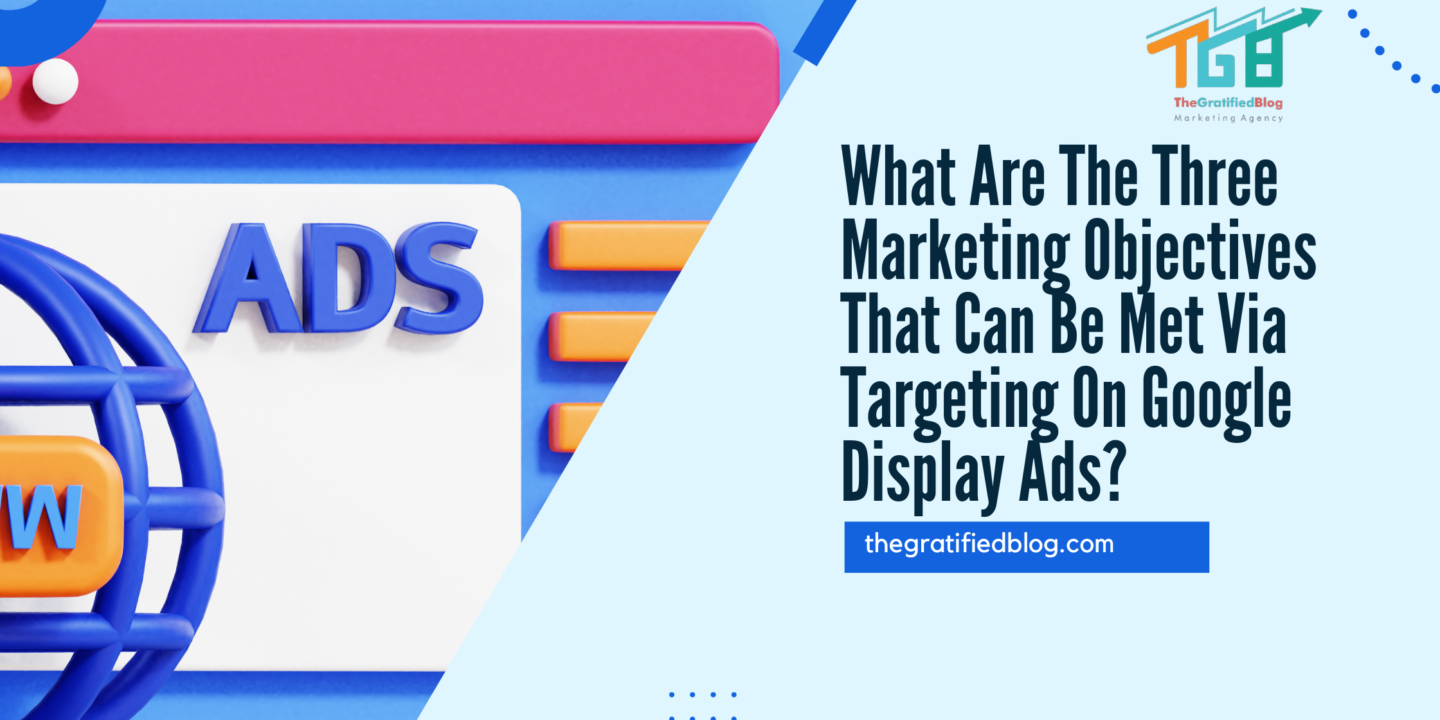
Imagine effortlessly meeting not one, not two, but what are the three marketing objectives that can be met via targeting on Google Display Ads? Through efficient and strategically launched Google Display Ads, you can achieve these crucial goals.
This is the desire of every entrepreneur and advertiser.
In this piece, we will explore methods for attaining this goal. But first, let’s see the three key marketing objectives that Google Display Ad Targeting can help you achieve.
What is Google Display Ad Targeting About?
Google Display Ad Targeting refers to the methods and strategies advertisers use to reach specific audiences when displaying ads on the Google Display Network (GDN). The Google Display Network is a vast collection of websites, apps, and other online platforms where advertisers can showcase visual ads to a wide audience.
Google Display Ad Targeting comprises various key aspects, such as demographic and interest-based focus, contextual and placement precision, remarketing strategies, and adaptable ad formats, all aimed at efficiently reaching and engaging specific audiences across the Google Display Network.
What Are The Three Marketing Objectives That Can Be Met Via Targeting On Google Display Ads?
Google Display Ad retargeting can help you achieve pivotal marketing objectives that include:
- Precision in Audience Engagement
Have you ever wondered, what are the three marketing objectives that can be met via targeting on Google display ads? Google Display Ad targeting empowers you to pinpoint and engage with your ideal audience. You can make your advertisements more effective by using demographic information, hobbies, and online activity.
This degree of accuracy makes sure that your message reaches the people who are most inclined to buy, increasing the success of your marketing efforts overall.
Google Display Ad Targeting leverages a wealth of data, from demographics to online behavior. This enables you to hone in on your ideal audience with surgical precision, ensuring your message reaches those most likely to engage and convert.
The ability to tailor ads based on audience segments also allows for a personalized approach. This not only enhances relevance but also establishes a connection that resonates with individual preferences and needs.
- Brand Visibility Amplification
Ever felt the frustration of a well-crafted message not getting the attention it deserves? Google Display Ad targeting tackles this by enhancing brand visibility.
Through strategic ad placements on websites relevant to your audience, you amplify your brand’s presence, creating lasting impressions that contribute to brand recall and trust.
Google Display Ads don’t just appear anywhere; they strategically position themselves on websites relevant to your target audience. This ensures your brand is seen in contexts that matter, amplifying visibility where it counts the most.
From eye-catching visuals to engaging multimedia, the versatility of ad formats allows you to capture attention creatively. This adaptability contributes to increased visibility and memorable brand experiences.
- Conversion Catalyst
The ultimate goal of any marketing effort is conversion, and Google Display Ad targeting serves as a catalyst for driving actions. Whether it’s encouraging a purchase, sign-up, or another desired outcome, the ability to tailor your message to the right audience increases the likelihood of conversions.
This not only boosts immediate results but also establishes a foundation for long-term customer relationships.
Google Display Ad Targeting excels in understanding user behavior. By tapping into insights on what users are interested in, you can tailor your ads to align with their preferences, increasing the likelihood of conversions.
The ability to re-engage users who have interacted with your brand but haven’t converted is a game-changer. Google Display Ad Targeting enables dynamic retargeting, ensuring your brand stays top of mind, leading to higher conversion rates.

What are key steps to using Google Display Ad Targeting to achieve your marketing goals?
Understanding ‘what are the three marketing objectives that can be met via targeting on google display ads’ is vital. With that foundation, consider these key steps following these key steps:
- Define Clear Objectives
Clearly outline your marketing goals. Whether it’s increasing brand awareness, driving conversions, or reaching a specific audience, having well-defined objectives sets the foundation for a targeted approach.
- Audience Segmentation
Leverage the power of audience segmentation. Use Google Display Ad Targeting to identify and categorize your audience based on demographics, interests, and online behavior. This segmentation allows you to tailor your ads to specific audience subsets. One method to achieve the marketing objectives, like ‘what are the three marketing objectives that can be met via targeting on google display ads’, is through optimal contextual targeting.
- Craft Compelling Creatives
Design visually appealing and compelling creatives. Capture attention with engaging visuals, concise copy, and a clear call to action. Ensure that your creatives align with your brand messaging and resonate with your target audience.
- Utilize Responsive Ads
Embrace responsive ad formats. Google Display Ad Targeting supports responsive ads that automatically adjust their size and appearance to fit different placements. This flexibility enhances the reach and effectiveness of your ads across various devices and screen sizes.
- Contextual Targeting
Optimize for contextual targeting. Ensure your ads appear on websites and platforms relevant to your audience. Strategic placement enhances the contextual fit of your ads, increasing the likelihood of engagement.
- Implement Remarketing Strategies
Harness the power of remarketing. Target users who have previously interacted with your brand but haven’t converted. Dynamic remarketing, in particular, allows you to show personalized ads based on users’ past interactions, reinforcing brand recall.
- Set Bid Strategies
Choose appropriate bid strategies. Google Display Ad Targeting offers various bidding options, including cost-per-click (CPC), cost-per-thousand-impressions (CPM), and cost-per-acquisition (CPA). Select a strategy aligned with your campaign goals and budget.
- Monitor and Analyze Performance
Regularly monitor the performance of your ads. Utilize Google Analytics and other tracking tools to gather insights on impressions, clicks, and conversions. Analyze this data to refine your strategy, identify successful elements, and optimize underperforming aspects.
- Adjust and Optimize
Be proactive in adjusting your campaign based on performance insights. Optimize targeting parameters, tweak ad creatives, and refine your approach to align with evolving market trends and audience behavior.
- Test and Iterate
Conduct A/B testing to refine your strategies. Test different ad creatives, targeting options, and ad formats to identify what resonates best with your audience. Use the insights gained to iterate and continually enhance your campaign.
How to use Google Display Ad Targeting to reach a wider audience and make your brand more visible
By strategically incorporating these tactics, Google Display Ad Targeting becomes a potent tool for reaching a wider audience and enhancing your brand’s visibility across the digital landscape.
Here’s what to do to use Google Display Ad targeting to reach a wider audience:
- Audience Expansion
Utilize Google Display Ad Targeting to expand your reach beyond your current audience. Experiment with broader demographic targeting, allowing your ads to reach a wider spectrum of potential customers.
- Contextual Targeting Across Relevant Websites
Opt for contextual targeting to ensure your ads appear on websites relevant to your industry or niche. This strategy broadens your brand’s visibility within contexts that align with your products or services.
- Explore Placement Options
Take advantage of diverse placement options offered by Google Display Network. This includes placements on websites, mobile apps, YouTube, and more. By diversifying your placements, you increase the likelihood of reaching a wider and more varied audience.
- Responsive Ads for Various Devices
Create responsive ads that adapt to different devices and screen sizes. This ensures a seamless viewing experience for users on desktops, tablets, and mobile devices, maximizing your brand’s visibility across various platforms.
- Incorporate Visual Appeal
Craft visually appealing and attention-grabbing creatives. Invest in high-quality images and design elements that stand out. The visual appeal of your ads plays a crucial role in capturing the attention of a wider audience.
- Leverage Video Ads
Integrate video ads into your display campaign. Video content has a high engagement potential and can significantly increase brand visibility. Showcase your brand story or highlight key products and services through compelling videos.
- Dynamic Remarketing
Implement dynamic remarketing to re-engage users who have previously visited your website. Show personalized ads based on their past interactions, reminding them of your brand and encouraging a return visit or conversion.
- Expand Geographical Targeting
Extend your geographical targeting to reach audiences in different regions. This is particularly effective if your products or services have a broader appeal and can cater to diverse locations.m
- Frequency Capping
Implement frequency capping to manage how often your ads are shown to the same user. This prevents ad fatigue and ensures a more balanced and positive user experience, especially when aiming for wider visibility.
- Exclude Irrelevant Audiences
Use exclusion targeting to prevent your ads from being shown to audiences that are unlikely to be interested in your products or services. This can help optimize your budget and focus on the most relevant users.
Conclusion
Overall, mastering the art of Google Display Ad Targeting opens a gateway to achieving paramount marketing objectives. By harnessing audience precision, strategic brand visibility, and conversion optimization, your brand can transcend conventional boundaries. The key lies in defining clear goals, embracing diverse ad formats, and constantly refining your approach based on performance insights.
Remember, Google Display Ad Targeting isn’t just about displaying ads; it’s about strategically positioning your brand for maximum impact, visibility, and engagement.








No Comments